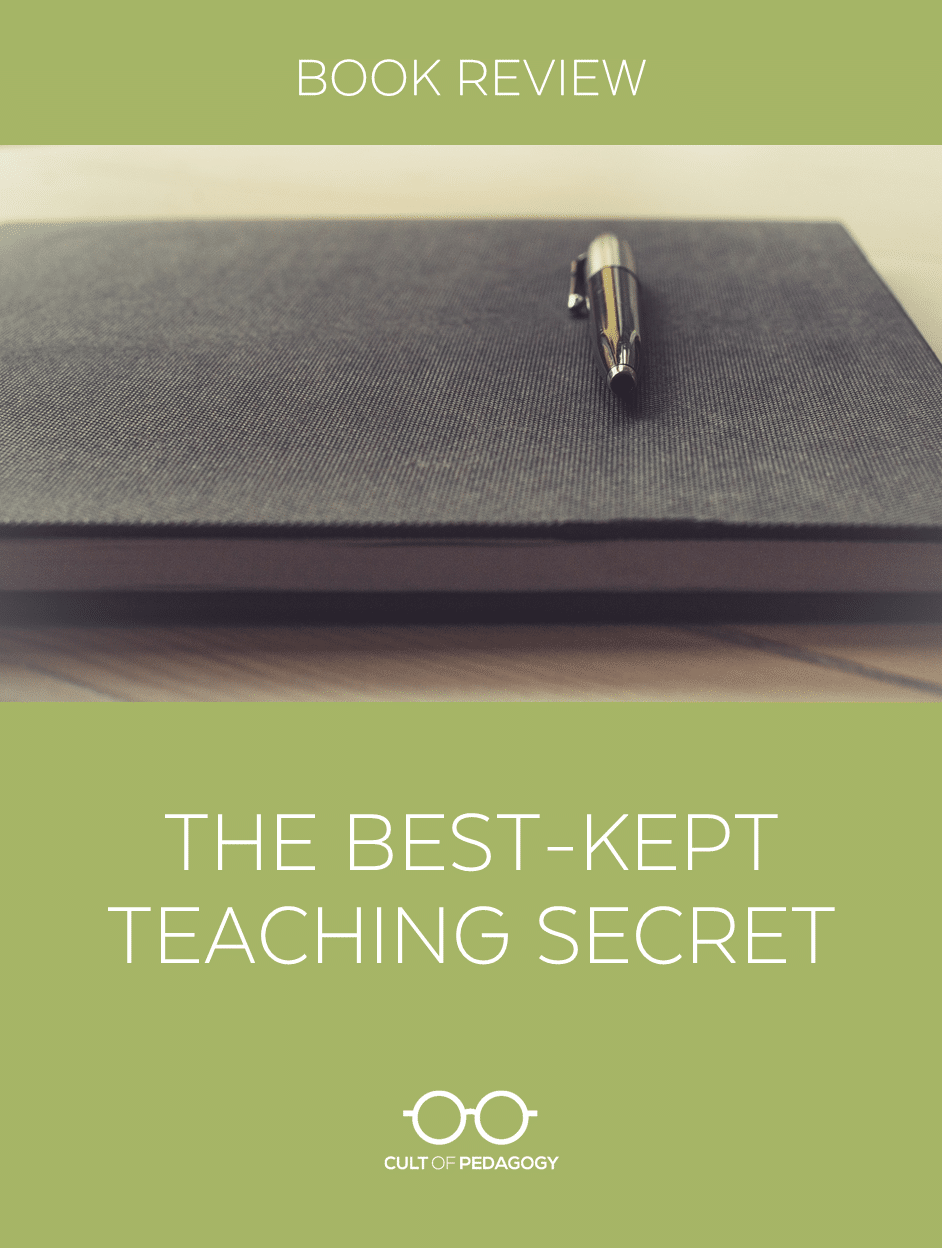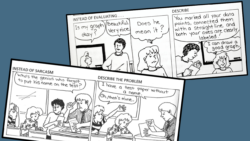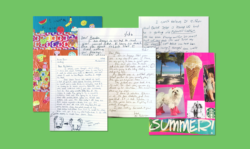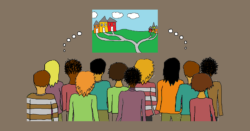
All links to this book are Amazon Affiliate links, which means I receive a small commission on any purchase you make during that visit at no extra cost to you. Thanks for your support!
Picture this: You just showed students a thought-provoking video clip that illustrates something in your content area. Now, instead of asking the whole class what they thought about it (which can lead to Fisheye Syndrome), or handing out a review worksheet, you put students in small groups.
Every student has a blank sheet of paper. When you say “Go,” each student responds, in writing, to this question: What did you learn from this video that surprised you? After a few minutes, you tell students to pass this paper to the student on their right. Each student writes a response to the paper they have just received. A few minutes later, they pass their papers again and respond to the first two comments. Once this third rotation is done, you tell students they may begin discussing their ideas out loud. Which they do. With way more energy and enthusiasm than they would have if you’d simply stopped the video and said, So what do you think?
This technique, called a write-around, is one of many described in Harvey and Elaine Daniels’ new book, The Best-Kept Teaching Secret: How Written Conversations Engage Kids, Activate Learning, and Grow Fluent Writers, K-12. The book’s premise is simple: If we have our students write informally more often, in every content area, we will dramatically improve learning, behavior, engagement, test scores, even our own job satisfaction. Using specific, easy-to-follow instructions and lots of examples, the authors show us exactly how to do this.
The Best-Kept Teaching Secret: How Written Conversations Engage Kids, Activate Learning, and Grow Fluent Writers
by Harvey A. “Smokey” Daniels & Elaine Daniels, 248 pages, Corwin Literacy, October 2013
When I started reading this book, I was skeptical. The table of contents listed topics I was already familiar with: exit slips, online message boards…was this book just repackaging strategies that have been around for decades? That argument could definitely be made. But I would argue that in this case, the “repackaging” has value. It gathers up techniques that have been used loosely, on their own, and lines them all up as components of a larger body. In the same way that cooperative learning is a blanket term for a variety of collaborative strategies, the informal writing tools described in this book have now been given their own collective term: written conversations. As we continue to study and practice what works in education, it’s challenging to keep up with every little technique; stopping periodically to group them helps us build a common language and stay organized as a profession.
But that’s just the beginning. This book goes well beyond a simple listing of strategies. Here are some of its best features:
Application in all content areas and age groups: The authors show how to use the strategies in a variety of content areas and with all age groups, even those in K-1 who will not all be able to write. In the examples of written conversations in math, science, social studies, and foreign language, we see that these tools are not just add-ons, but a way to get students thinking deeply about content. If you’ve been struggling to meet the Common Core standards for content-area literacy, this book is a gold mine.
Model lessons: For each strategy, the authors walk the reader through a lesson that puts it in context, showing what happens before, during, and after the use of the strategy. In these walk-throughs, we hear exactly what the teacher would say to introduce students to the activity and how they respond to students in the process. This was what really made the book valuable to me, because reading a description of a strategy only gets you so far; until you “see” it in action, you run a much greater risk of doing it wrong and discarding it as useless.
Student samples: The book is loaded with samples of real written conversations between students and teachers. At times I felt there was a little overkill in this area, but I would rather there be too many examples than not enough. The samples give the reader a clearer picture of what’s possible in written conversations: Students arguing about content with supporting evidence. Students paraphrasing one another’s contributions. Students defending their ideas with logic and reasoning, developing and expanding on these ideas with examples and details. All the things we want them to do in their more formal writing. There’s serious academic work going on in many of these interactions; the samples are the proof.
Practical advice: Some readers may see written conversations as impractical or hard to manage, and the authors try to anticipate and address many potential reader questions. When I read about dialogue journals, my first thought was how I could possibly manage them with a typical middle-school roster of 100+ students. This concern was addressed within a few pages. The authors suggest ways to respond to larger numbers of students (without adding extra work to our load) and advise us to have students spend the bulk of their time writing to each other. Plenty of other questions are answered as well, such as how to grade these written conversations and what to do with students who don’t take them seriously.
A return to the “whole child.” Our current educational climate focuses so much on measurable data. Although the techniques in this book should ultimately improve test scores, written conversations go well beyond that, helping us connect to and nurture many more aspects of our students’ growth. In using these tools, we get to know our students better, we build more trust and compassion within our classrooms, and with our own writing, we model a whole lot of other things for them — not only mature writing and thinking skills, but attitudes and values that contribute to their overall character and love of learning.
Things have gotten awfully complicated and contentious in education lately. This friendly, easy-to-read book offers something we’re all looking for these days: simple ideas with big impact. ♦
Join my mailing list and get weekly tips, tools, and inspiration—in quick, bite-sized packages—all geared toward making your teaching more effective and fun. By subscribing, you’ll get access to my Members-Only Library of free downloads, including my e-booklet, 20 Ways to Cut Your Grading Time in Half, which has helped thousands of teachers spend less time grading!






The description of the written conversation also reinforces point made by Peter C. Brown et al. in Make it Stick, about processing information to help deepen the memory and retention of content.
You’re absolutely right. That’s a perfect connection!
I pair up kids from my class and another class and they send each written conversations about a section of the book by email or WhatsApp messages. They often have better evidence, analysis and structure than their essays. They claim that it is because I’m not watching and it is isn’t called an ‘essay’
I have a question about the book “the best kept secret”. What is the main target group of students? I teach 15-18 year olds in German (I teach in Austria), is it usable four this age, too or rather for primary school?Thank you for your great blog!
Hi Agnes! The book was written for any age group, but we think it would definitely work great for those working with older kids.